

Using open tools to create the digital map of Cairo’s public transit. Follow the authors, Tatiana (@tatipq) and Diego (@canaless) on Twitter The first step in any transit planning process involves understanding the current supply and demand of transit services.
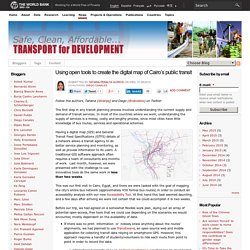
In most of the countries where we work, understanding the supply of services is a messy, costly and lengthy process, since most cities have little knowledge of bus routes, services and operational schemes.
Urban Mobility System Upgrade. The 2015 European Railway Performance Index. For national railway systems in Europe, public subsidies provide essential funds to support infrastructure maintenance and passenger and freight operations.
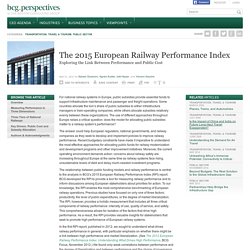
Some countries allocate the lion’s share of public subsidies to either infrastructure managers or train-operating companies, while others allocate subsidies relatively evenly between these organizations. The use of different approaches throughout Europe raises a critical question: does the model for allocating public subsidies matter to a railway system’s performance? The answer could help European regulators, national governments, and railway companies as they seek to develop and implement policies to improve railway performance. Recent budgetary constraints have made it imperative to understand the most effective approaches for allocating public funds for railway modernization and development programs and other improvement initiatives. Our current report confirms the correlation between performance and public cost.
Facebook. 7 Benefits and 1 Huge Problem With a World Full of 'Taxibots,' or Driverless Taxis. A city where private cars are largely replaced with driverless taxis doesn't feel terribly close, but it's not too far away to think about.
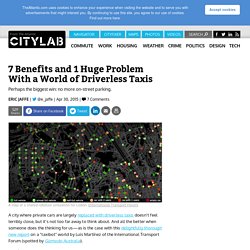
And all the better when someone does the thinking for us—as is the case with this delightfully thorough new report on a "taxibot" world by Luis Martínez of the International Transport Forum (spotted by Gizmodo Australia). Martínez and collaborators used real trip data to model what life would be like in Lisbon, Portugal, if shared autonomous vehicles of various size ruled the streets. Some scenarios had these taxibots partnering with high-capacity public transit—in Lisbon's case, a subway network—while others considered a transit-less city. (Though taxibots replaced local buses in all cases.) At half a million city and 2.8 million metro area residents, Lisbon is a pretty typical midsized city, though it's car-ownership rate (217 per 1,000 people) is on the lower end of the global scale.
The good news first—then the bad.
Mobility-Employment-Salary. Cualitativos. U de A - In-movilidad en Medellín, un debate de La Fuerza de los Argumentos (2015) 7 ciudades que están sacando los automóviles de sus calles. Es uno de los grandes cambios que están viviendo las ciudades en nuestros días.

El reinado del automóvil ha llegado a su fin y el espacio de las calles va de a poco siendo devuelto a las personas. Hoy son cada vez más evidentes los efectos negativos que los automóviles tienen en nuestras ciudades. Los más evidentes son la contaminación del aire, los accidentes de tránsito y, por supuesto, todo el espacio que ocupan, que generan congestión y que nuestras calles sean poco amables con quienes caminan. En muchas ciudades hoy moverse en automóvil no es la manera más eficiente de hacerlo. Por ejemplo, en Londres un auto se mueve más lento que un ciclista promedio, en Santiago la situación no es distinta según la 7ª Medición de Tiempos de Viaje. En Fast Company hicieron una selección de 7 ciudades que van adelante en este proceso, que es probable que vivan todas las ciudades en un futuro no muy lejano. 1.
Aquí un par de artículos de Plataforma Urbana donde les contamos sobre este plan de Madrid: Using open tools to create the digital map of Cairo’s public transit. Moovit, la revolución del transporte público. Pedaleable. Tallinn’s transit free-for-all - GE Look Ahead. What if taking a bus or a trolley or a train was as cheap and easy as driving or walking?

Now, imagine they were free—how often would you ride them? And to where, for what reasons? These were the questions on the city officials’ minds when Tallinn—the capital of Estonia—abolished fares for 430,000 residents last year. 4 Scenarios For The Future Of Transportation. Más vias no son la vía. Democratización del transporte público. European Green Capital.
A recent mobility survey carried out by the City Planning Department in Helsinki has revealed that on a weekday 34% of citizens walk and 32% use public transport.
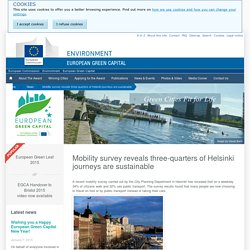
The survey results found that many people are now choosing to travel on foot or by public transport instead of taking their cars. Helsinki, Finland. Photograph: Hemis/Alamy via theguardian.com Researchers found that females between the ages of 7-17 traveled most often with an average of four trips a day. People over 65 were found to make more than two trips over the same period. The survey took place in September and October 2014 and 3,000 city residents were interviewed. Hamburg’s Plan to Eliminate Cars in 20 Years. Hamburg's Plan to Eliminate Cars in 20 Years About 40% of the area of Hamburg, the second largest city in Germany, is made up of green areas, cemeteries, sports facilities, gardens, parks and squares.
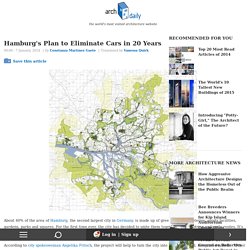
For the first time ever, the city has decided to unite them together via pedestrian and cycle routes. It's all part of the "Green Network Plan," which aims to eliminate the need for vehicles in Hamburg over the next 20 years. According to city spokeswoman Angelika Fritsch, the project will help to turn the city into a one-of-a-kind, integrated system: "Other cities, including London, have green rings, but the green network will be unique in covering an area from the outskirts to the city centre. Francia exige a las autopistas parte de su beneficio.
Discrete Choice Analysis. Sunday, March 20 - Thursday, March 24, 2016.
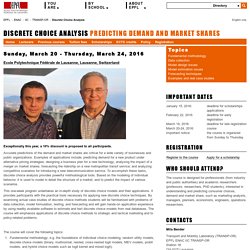
Leaders in Urban Transport Planning Program (LUTP) Brochure: Overview of the LUTP Program As cities become the engines of economic growth, city officials and decision makers face a challenging task of developing and maintaining efficient urban transport systems.

These systems must address the problems of severe congestion, deteriorating air quality, energy sustainability, and increasing numbers of road accidents. However, urban transport planning and management is complex. It is more than choosing technologies. Portafolio.co.